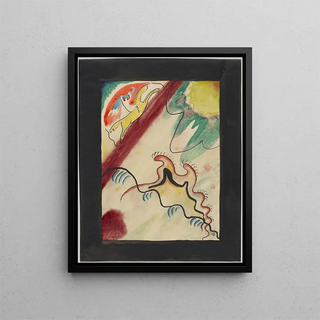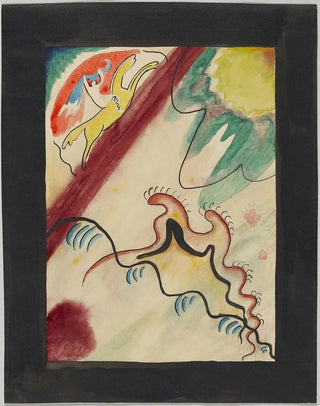Art print | Cover design of the Le Cavalier Bleu IX almanac - Wassily Kandinsky


View from behind

Frame (optional)
Conception of the cover art for the Le Cavalier Bleu IX almanac - Wassily Kandinsky – Captivating introduction
The art print of the cover of the Le Cavalier Bleu IX almanac, an iconic work by Wassily Kandinsky, embodies the avant-garde spirit of the early 20th century. This masterpiece is not limited to a simple illustration; it represents a true exploration of shapes and colors, an invitation to delve into the abstract universe of the master. As a founding member of the expressionist movement, Kandinsky was able to transform complex ideas into an accessible artistic vision, captivating the viewer's eye and mind. The cover of this almanac, published in 1924, reflects his commitment to redefining the artistic conventions of his time, while offering a reflection on spirituality and emotion.
Style and uniqueness of the work
The work stands out for its bold use of colors and geometric shapes. Kandinsky, a true pioneer of abstraction, skillfully plays with contrasts to evoke an immediate emotional response. Circles, triangles, and sinuous lines intertwine in a harmonious dance, creating a dynamic composition that draws the eye and stimulates the imagination. The vibrant and varied color palette evokes sensations that are sometimes joyful, sometimes melancholic, thus revealing the depth of human emotions. Every element of the cover seems carefully thought out to provoke reflection on the relationship between art and perception, making this work not only aesthetic but also deeply philosophical.
The artist and his influence
Wassily Kandinsky, born in Russia in 1866, is often considered one of the pioneers of abstract art. His artistic career was marked by an unceasing quest for harmony between color and form. Influenced by movements such as Fauvism and Cubism, he created a unique visual language that transcends cultural and temporal boundaries. Kandinsky was also a prolific art theorist, writing major works that explore the concepts of modern art and its impact on society. His influence is still felt today, not only in the art world but also in music, literature, and the

Matte finish

View from behind

Frame (optional)
Conception of the cover art for the Le Cavalier Bleu IX almanac - Wassily Kandinsky – Captivating introduction
The art print of the cover of the Le Cavalier Bleu IX almanac, an iconic work by Wassily Kandinsky, embodies the avant-garde spirit of the early 20th century. This masterpiece is not limited to a simple illustration; it represents a true exploration of shapes and colors, an invitation to delve into the abstract universe of the master. As a founding member of the expressionist movement, Kandinsky was able to transform complex ideas into an accessible artistic vision, captivating the viewer's eye and mind. The cover of this almanac, published in 1924, reflects his commitment to redefining the artistic conventions of his time, while offering a reflection on spirituality and emotion.
Style and uniqueness of the work
The work stands out for its bold use of colors and geometric shapes. Kandinsky, a true pioneer of abstraction, skillfully plays with contrasts to evoke an immediate emotional response. Circles, triangles, and sinuous lines intertwine in a harmonious dance, creating a dynamic composition that draws the eye and stimulates the imagination. The vibrant and varied color palette evokes sensations that are sometimes joyful, sometimes melancholic, thus revealing the depth of human emotions. Every element of the cover seems carefully thought out to provoke reflection on the relationship between art and perception, making this work not only aesthetic but also deeply philosophical.
The artist and his influence
Wassily Kandinsky, born in Russia in 1866, is often considered one of the pioneers of abstract art. His artistic career was marked by an unceasing quest for harmony between color and form. Influenced by movements such as Fauvism and Cubism, he created a unique visual language that transcends cultural and temporal boundaries. Kandinsky was also a prolific art theorist, writing major works that explore the concepts of modern art and its impact on society. His influence is still felt today, not only in the art world but also in music, literature, and the






